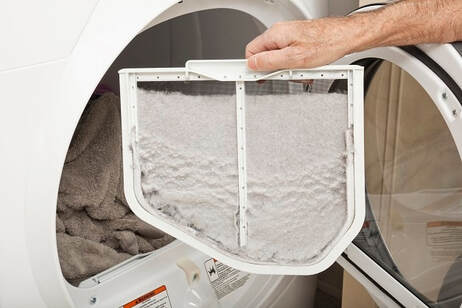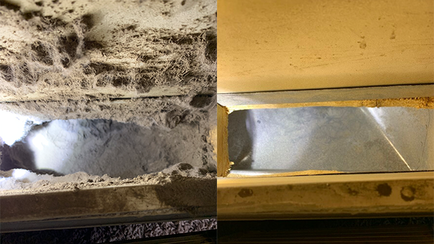 The blaring warnings. Several years ago, I was stunned when a friend told me her previous home had burned down because they had neglected to clean the dryer vent. Oblivious to what a dryer vent actually consisted of, I thought she meant the lint trap compartment. A year or so later, a firefighter on a courtesy visit to our home to look for potential hazards, when entering the laundry room, announced, “Dryer lint is the most combustible material in your home.” Without those two blaring warnings, I would have remained oblivious to the dangers of dryer lint, as I suspect many people do, based on the number of home fires that occur every year for that very reason. The US Fire Administration states that “2,900 home clothes dryer fires are reported each year and cause an estimated 5 deaths, 100 injuries, and $35 million in property loss,” and that the majority of clothes dryer fires are caused by clogged dryer vents. What you can do. Every time you dry a load of laundry, some of the lint from the clothes loosens. Though some of this loose lint is caught by the lint trap, some of it slips past (as evidenced by the clumps you’re likely to observe if you remove the lint trap and look underneath it) and enters the machine itself and the venting system. This renegade lint builds up over time, restricting air flow and creating a fire hazard. Here are some things you should do to keep yourself and your family safe, some obvious, some perhaps not so:
Some considerations. Consider having your dryer vent cleaned more frequently if the vent line has several turns, which would allow more opportunities for lint to become trapped, and additionally render an effective cleaning more difficult. You'll also want to do it more frequently if the outside vent is located on a floor other that where the dryer itself is located, which would indicate a longer run. Also, the more frequently you do laundry the more often you’ll want to have the dryer vent cleaned. (Want to learn more about the cleaning process itself? Visit our dryer vent cleaning service page.) Some signs that your dryer vent is in need of cleaning include the machine taking longer than usual to dry a load of laundry, large amounts of lint collecting in the lint trap and around the drum, clothes feeling hot to the touch after a cycle, and the outside vent flap not opening when the dryer is running (air flow should be pushing this open, so its failure to do so could signal a blockage). Finally, although do-it-yourself dryer vent cleaning tutorials abound on the internet, best to consider hiring a professional for the job. Their specialized tools successfully navigate 90-degree turns, jostle around inside the duct to loosen and break up lint, and blast debris toward the outside much more effectively than any high-powered leaf blower. So there’s your blaring warning. Tuck it inside your brain, and when the time comes, call a professional.
0 Comments
 The Process: in a Nutshell. The air duct cleaning process generally consists of 1) creating access points (holes) in the main trunk line for the insertion of tools, 2) placing a vacuum near the return plenum in order to create negative pressure and to contain the dust generated, and 3) employing various pneumatic tools inside the ductwork to jostle around and move any debris toward the containment system (vacuum). There are a variety of tools in each of these categories to help get the job done. Want to learn more about the process itself? Visit our air duct cleaning service page. Access tools Before the cleaning process can begin, the technician will need to gain access to the trunk lines. He’ll do this by creating holes (the minimum number and size necessary to accomplish an effective cleaning) in the ductwork. The size of the access point will depend upon the type of tool that’s going to be inserted. A 1-inch hole will suffice for most air balls and air whips. A 6-inch hole would be required to accommodate many rotary brush heads. A hole this size would also allow for the insertion of a standard-sized duct-cleaning vacuum hose. In order to create minor access points, the technician would likely utilize a drill with a one-inch Unibit or Vari-bit. For greater access, drill-powered or electric shears, or pneumatic cutters, may be utilized. Tin snips may be used to clean up some edges, if necessary. Once the cleaning is complete, the technician will seal the smaller access points with rubber duct plugs. Larger holes will be closed up with sheet metal patches sealed with foil tape or duct tape, with gasket tape being used on larger patches (mostly in a commercial environment). Cleaning toolsAir duct cleaning tools are many and varied but their general purpose is similar: to jostle, blow, spin, or whip around inside the duct, agitating debris and propelling it into the airstream and toward the containment system. Tools or nozzles are attached to long, flexible rods or cables that are fed into the ducts by the technician. Rotary brushes with firm but flexible nylon bristles spin around and sweep the sides of the ducts. A more gentle brush head with soft-poly bristles may be used for cleaning flex-duct or insulated ductwork. High-powered blow nozzles and air wands use high-pressured air to “air-wash” the register covers and the area immediately inside the vents, pushing debris toward the main line, where other tools coax it toward the vacuum. Air whips with plastic tentacles thrash aggressively against the sides of the ducts to loosen any debris, and with the aid of air blasts from their nozzles (reverse or forward), send it toward the containment system. Multiple-tentacled whips, such as the Viper Clean Sweepsystem or the Octopus Predator Whip, provide one of the most thorough cleanings available, as their many tentacles whip around in a rapid blur, contacting every square inch of the interior ductwork surface. (On watching these tools in action, the aggressive movements of the tentacles in every direction appear to be haphazard, but the result is anything but). Vacuum/containment systems and compressors The suction provided by vacuum (negative pressure) in concert with the air pressure produced by compressors provide the one-two punch of air duct cleaning. Power matters here—a truck-mounted vacuum and compressor-fed air whips are going to be far more effective, say, than your do-it-yourself leaf blower and a hand vac. Most duct cleaning companies rely on gas-powered, truck-mounted vacuums boasting suction power of up to 12,000 CFMs. When using this equipment, the technician will typically park as close to the home as possible and run the vacuum hose, about 6 inches in diameter, from the truck down to the furnace. With a truck-mounted vacuum, some of the power is lost in the hose length (suction power decreases the further you move away from its source), so typically, at the point of hookup, suction power is diminished to roughly 5-7000 CFMs, depending on the length of hose needed. This range is still plenty of power to provide good suction and result in a thorough cleaning. An alternative to truck-mounted systems are portable duct-cleaning vacuums. These are electric-powered and sit in a wheeled housing, allowing them to be moved fairly easily to where they’re needed. Portable vacuums can crank out up to 5000 CFMs, but the suction is provided much closer to the furnace than that of truck-mounted systems, so final suction power can be quite comparable between the two. Moreover, portable vacuums can be used in environments where truck-mounted equipment simply isn’t an option, such as when no parking is available, or in upper-floor dwellings. Necessary partners in duct cleaning to the vacuum are the compressors, which provide the air-pressure needed to power pneumatic cleaning tools such as air whips, air wands, air snakes, etc.—the real soldiers. Compressors are generally truck-mounted and generate at least 175 psi or greater. They can be gas or electric powered. Portable varieties are available, in cases where access for a truck would be limited, such as high-rise buildings or in commercial settings. Modern air duct cleaning tools are diverse and powerful, allowing for effective cleaning of air ducts in a variety of circumstances and settings. Not all tools will be appropriate in every setting, but a diverse arsenal in the hands of a skilled and dedicated technician will virtually guarantee the most effective cleaning possible. Wanna dig deeper? Download our free tipsheet: 10 Questions to Ask Before Hiring an Air Duct Cleaning Company. Download Tipsheet Many thanks to our technician Ben S. for lending his expertise to this article. |
SearchArchives
April 2022
|
Twin Cities Furnace Cleaning - Open 7 Days a Week 8AM to 8PM
